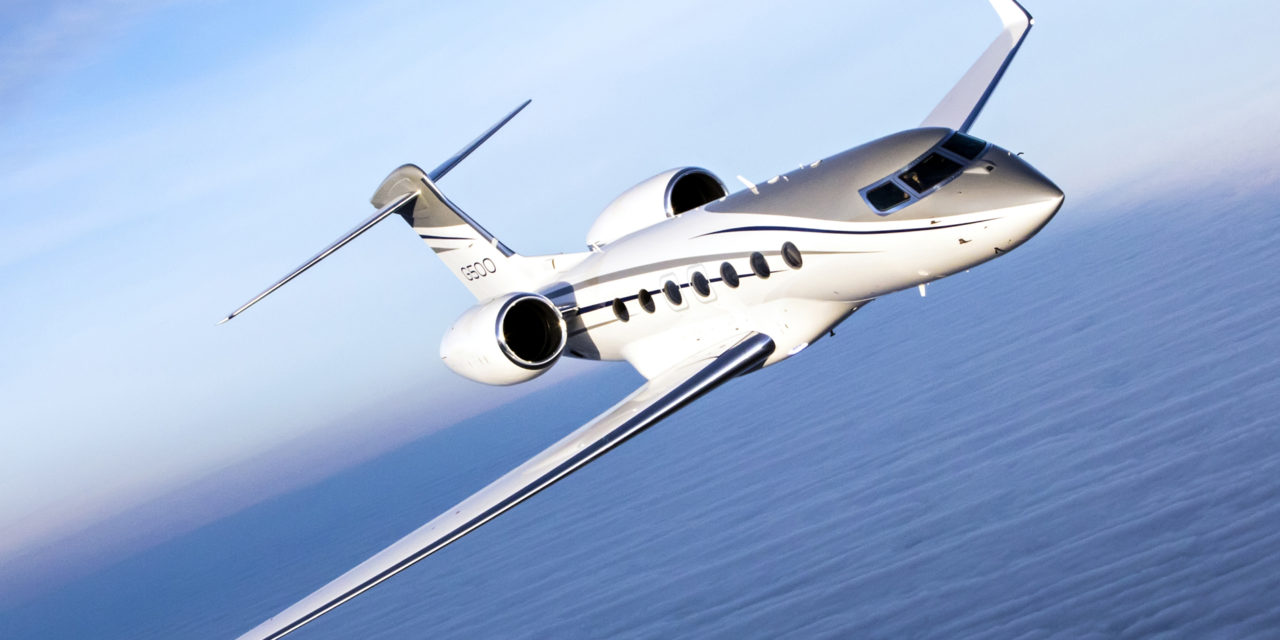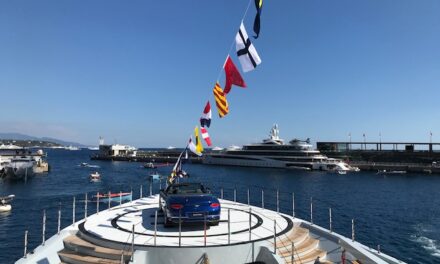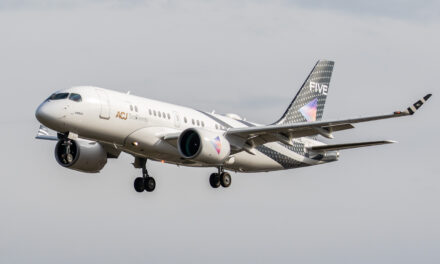There we were, doing .91M at 50 000 feet barely 19 minutes after takeoff (with 2 stops at FL250 and FL420) … watching the U.S. East Coast and the Atlantic Ocean closing in, and the line of cumulonimbus disappearing below us … in Gulfstream’s brand new G500.
My day had started early on this national vacation in Savannah Georgia. I had come in late the night before from Atlanta to meet with Heidi Fedak, director of corporate communications and media relations, and the rest of the Gulfstream team at 0900 the next day. We were there promptly, after the usual van ride and the familiar gate access procedure.As usual Heidi was at the door of the Gulfstream Sales and Design Center, waiting for me to show up to meet my crew for this demo flight: Scott Evans, Gulfstream’s director of flight operations and corporate demonstration, as safety pilot and Brian Dickerson, chief pilot of Gulfstream large-cabin aircraft as my captain.
A new Gulfstream era
The G500 and its slightly longer twin, the G600, were first publicly unveiled by Gulfstream in mid-October 2014 with a powered roll-out by the G500 and a first flight on May 18 2015.
A range increase was announced at NBAA 2017 after both aircraft exceeded their initial performance design numbers: the G500 range increased to 5200 Nm of range at.85M and 4400 Nm at .90M and the G600 range went up to 6500Nm at .85M and 5100Nm at .90M.
The new features revolutionizing Gulfstream’s large-cabin line-up, apart from the bird of prey look of both models, include: new digital fly-by-wire flight controls with digital sidesticks in place of the traditional control yoke (a first for Gulfstream and business aviation), new Pratt & Whitney Canada PW800-series engines, a new approach to flight-deck design, data distribution and systems integration, with the new Symmetry Flight Deck, the Intelligence-by-Wire concept and the Data Concentration Network reducing wiring and parts. Last, but not least, a new wing evolution from the G650’s airfoil gives this sense of speed to the new additions to the Gulfstream family. In early July, the G500 program was at the final stage of its certification process and, as a matter of fact, as we go to press, the G500 is now FAA certified. Lots of work was achieved by Gulfstream to complete all this at this pace.
A structural test lab worked on a full-scale static G500 frame (S72) to complete most of the structural steps for both types, including worst case load combinations and 150% wing bending; at the same time, a G500 airframe was put in a long-term fatigue tolerance process to test the G500 and G600 to three lifetimes or 55500 flight cycles. 37000 hours of lab testing were done before the G500 went airborne for the first time; this explains the flawless flight test program. Five G500 test aircraft were flown for more than 5100 hours in 1400+ flights in support of the test program, completing performance, flight characteristics, braking, fuel, hydraulic and electric systems tests as well as cabin systems, lightning, fly-over noise tests etc. Commonality between the G500 and 600 means that the test program of the latest will benefit from the certification program of the 500.
Prepare for entry into service
Talking about commonalities: both aircraft share the same number of oval windows (14) the same flight deck, the same rudder and similar engines but with different thrust ratingsr, and the same wing design derived from the 650’s airfoil. The flight testing of the 600 is now well underway with cabin systems and interior flight testing complete and flying qualities, flight controls, field capabilities being worked on in early July. Formal FAA as well as EASA certification are expected late this year for an entry into service in 2019. Multiple other activities are in progress supporting the first G500 deliveries including classroom and simulator environments for maintenance and crew training being worked on (Gulfstream is teamed up with FlightSafety, and the first two full flight simulators are ready to start the first training session for type ratings as early as October), supplemental type certificate efforts for completion packages, FAA evaluation and approval of pilot training program, certification efforts for EASA and other authorities as well as pre-EIS (entry into service) meetings with operators, pilots, maintainers as well as flight attendants. The first customer G500 has received a certificate of airworthiness from the FAA. To ensure a smooth entry into service, Gulfstream is using its experience with the G280 and G650 to focus on readiness efforts and this flight test fleet to accelerate product improvements.
As well, a reliability, quality, availability action team (RQAAT) was established early during the flight test program, and customer support was taken into account very early in the test process with over 300 maintenance field service and technical operations specialists having received hands-on training on the G500. Furthermore over 2800 unique parts are being stocked with Gulfstream global distribution network, publications are being reviewed for the highest possible quality and maturity and specific ground support equipment is validated and on order for the different service centers. The famous Gulfstream world-class service is well underway! Two new production facilities for the G500 and 600 were built in Savannah and include state-of-the-art automation for the wings assembly. This facility is fully operational for the first deliveries expected later this year, and firm orders for the G500 are going strong.
Pre-flight check list
Scott is leading me through a thorough ground exterior check of our beautiful G500, N505GD, the fifth G500 built, and the first with a complete interior, while Brian updates our flight planning. The size of this bird of prey-like aircraft (27.8m-91ft2in in length, 26.31m-86ft4in wingspan and 7.78m-25ft6in in height) is larger than the typical G550, and Scott emphasizes that the 500 has almost the same aircraft cross-section as a G650 but for an 18cm (7in) reduction in width and height, and 5 cm (2in) more head room, 18cm (7in) more cabin width and 20cm (8in) more floor width than the G450/550. The beautiful wing and its prominent winglet is a supercritical design based on the 650’s wing design with the same 36° sweep and the difference between the 500 and 600 other than the fuselage section in front of the engines is a 2.5 m (8ft) difference in wingspan between the two models that allows for 4500 kg (11500lbs) of additional fuel. One very interesting feature is the huge single piece of flap on each wing and the clean design of its extension. It gives the aircraft high lift-to-drag ratio and enables slow approach speeds for landing. Scott takes some time to show me all service access doors and refueling panels, highlighting their easy and convenient access. The huge T-tail is based on the aerodynamic shape and systems of the 650’s tail. The engines are Pratt & Whitney Canada PW800 series Turbofan PW814 for the 500 and 815 for the 600. We pause for a moment on the baggage compartment with its access on the left part of the fuselage … its 175 cu feet of volume can hold luggage for a group of 13 persons and you can easily stand tall in it. Furthermore: the compartment is fully pressurized and accessible in flight. We access the interior by climbing the beautiful Gulfstream signature stairsthat are automatic or can be operated manually.
Digital cockpit
A glimpse of the cabin, and I can figure out the highest levels of luxury and I notice the aft galley option. In all large-cabin aircraft, Gulfstream offers the option of either a forward or aft galley, depending on the customer’s preference. Turning left to the flight deck, I am amazed by the clean design of the Symmetry Flight Deck: 80% of all switches and circuit breakers have disappeared and we are really getting into a new digital era with touchscreens everywhere. The sidesticks leave ample room compared to the classic control columns, and they are beautifully designed. Furthermore, the G500 and G600 are the first aircraft equipped with active sidesticks compared to Airbus or Dassault which use passive side-sticks.
Lots of research was done on their ergonomy taking into account wrist resting as well as on the active force feedback that puts pilots at the center of the loop, which enhances their situational awareness.
The sidesticks and Gulfstream’s fly-by-wire system provide full flight envelope protection (with no stick pusher or shaker), optimum handling qualities for all flight phases and reduced weight and maintenance costs. Brian shows me the left seat and we’re going through all functions available through the touchscreens, seven of which act as controllers of everything from flight planning to cabin control with a spare controller at the jumpseat position to replace any if one should fail. The controllers are intuitive and very user friendly and can be easily updated with software revisions. Honeywell’s Primus Epic system is the backbone of the G500 with four 14.1 in LCD displays, a 3D synthetic vision and a third generation enhanced vision system with 4 times better resolution than earlier versions. Three IRS (Inertial Reference Systems), a triple FMS (Flight Management System), two WAAS GPS receivers and three VHF navcom units get the Primus Epic flight deck to NextGen levels with RNP 0,1 capacity as well as FANS-1A pilot-controller datalink communications, full GPS and LPV capabilities.
We are loading up our flight plan using our touchscreens and very efficient cursor controls and in just a few minutes, we’re up and ready to start up the engines. The automatic checklists ease up the crew’s to-do lists and everything is made so that we are able to taxi in less than 10 minutes. Steering the ship is very easy using rudder for less than 40 degrees right or left and the tiller for more. Our brake-by-wire system, electrically operated and hydraulically actuated seems very efficient, and the best way to taxi in the G500 is with idle power with one thrust reverser up to be able to maintain a good taxi speed without accelerating too much.
Time to fly
Today our take-off weight with three persons on board and 11500 pounds of jet fuel (one-third of the max fuel) is 60 000 pounds and our computed speeds are V1: 118 kt for a rotation speed (Vr: 123) and a take off safety speed V2: 129 kt. Lined up runway 10 with our before-takeoff checklist complete and authorized by ATC, I gently advance the beautifully designed power throttles and at around 50% N1 push on the TOGA switches. We accelerate down the runway like a rocket ship racing for Vr and it had been a while since I had last stuck up to the stick like that due to such nice acceleration. Past Vr and a gentle pull on the sidestick gets us airborne with a 10 degrees nose up attitude, which is not enough as we are accelerating well past V2+10. 15 to 18 degrees is more relevant and Brian gets us cleaned up in no time (gear and flaps up). We’re passing 10000 feet with an astronomic vertical climb rate and I’m hand flying the G500 as much as I can. Roll and pitch controls are really light, and the active force-feedback gives me situational awareness about the jet’s speed. A pitch trim indicator on the PFD compares the indicated airspeed to the speed for which the aircraft is actually trimmed and forces are implied to the sidestick thus giving information to the pilots who can check their speed trend and trim the aircraft accordingly. Positive speed stability is the key here. To trim up the aircraft, I can either use the “cooly hat” trim actuator, very easy to use on the sidestick or use the red inbord button. This dual-function red button can be traditionally used to disconnect the autopilot when it is engaged or, while hand-flying the aircraft, can be used for instant trim with one single push … brilliant! We’re reaching FL250 for a short stop and are climbing for another stop at FL420 reached in eleven minutes … one last ascent and we’re reaching FL510 and M.91 in … twenty minutes!! That’s what’s performance is about! Before using the autopilot, I’m flying one or two turns by hand. The sidesticks are still responsive and precise, though one has to be gentle due to the reduction of the flight envelope at those altitudes. Brian tells me about the flight control laws: Normal, alternate, direct and Backup Flight Control Unit (BFCU), the latest being the most degraded but the simplest mode: computers translate pilot’s orders toward the actuators as if they were cables. The side-sticks provide consistent handling qualities independent of the aircraft’s CG position, weight, or pressure altitude and they offer full flight envelope protection without a stick-pusher but for direct law and BFCU modes. I check the different functions available through the touchscreens and find it amazing how simple and intuitive they are. One great feature of the G500 is that, at FL510, the environmental system gives us a cabin altitude of 4850 feet (one of the lowest cabin altitudes in the industry!) with a 10,69 psi differential! This makes a world’s difference regarding fatigue for the passengers and crew, especially for long-haul flights.
A new style cabin
Cruising at the ceiling of the beast, I’m taking some time to tour the cabin with Scott.
What strikes me first, even before the exquisitie taste, is the quietness … we are taking the first forward seats and we can talk to each other without raising our voices at all. Our seats, made of the finest leather, are just amazing: they’re huge, their pitch is 105-inch, can be moved forward, back, laterally, reclined all the way and a pair of seats can be transformed into single or double beds (four seats) with mattresses. The desks and armrests are made of luxurious brown wood and USB ports as well as iPods allow customers to recharge their batteries, connect themselves to the entertainment system and control the cabin environment. A couch that can sit at least three passengers can make a great full-size bed as well.
Thirteen people can experience the craftsmanship in the cabin for long hours with a lot less fatigue due to the environment and the cabin pressure. This particular aircraft has an aft galley. This flying three-star kitchen is designed to prepare gourmet meals for thirteen customers and more. You can find all the amenities needed: fridge and freezer, real oven, microwave, coffee machines, plenty of drawers for silverware, a solid workplace and even an electric wine cellar!
Aft is the flush toilet with its own window and a wash basin and Scott tells me that a shower option will be available for the G600. We finally reach the pressurized baggage compartment and as we can stand tall in it I can easily figure out that it can holds 175 cubic feet of volume!
Back to Savannah
Getting back to the cockpit, Brian briefs me on our new flight parameters: we are cruising at FL 490 at M.85 with a 2100lbs per hour per engine fuel flow … on a G600 with a full bag of gas at this speed and FL, we would probably go all the way to 6500Nm where the best Gulfstream contenders would make 6250Nm. Brian tells me that .85 is our max range speed versus .87 that is the best ratio for speed over range. He shows me the radar display that most accurately displays both the horizontal and vertical mapping of the cells and with weather information loaded through internet, our situation awareness is optimum. We’re fast reaching the sea and with perfect sky and a line of Cbs in front of us, we can easily figure out that we’ll fly over them. We start a descent toward FL240, and the sleek G500 doesn’t want to decelerate at idle descent, I’m extending the speed-brakes and with their use we can improve our rate of descent and decelerate without noise or vibrations. I’m back hand flying the aircraft for some nice steep turns and reverses. Through the full spectrum, the pilot feel is great and the G500 is an appeal for those who want to fly the aircraft manually … pure pleasure!
It’s time to head back to Savannah and a quick check of the latest weather and a few seconds of touchscreen selections (that are well thought of in case of turbulence!) and we’re all set for an RNAV Y approach to runway 28. We start our descent toward 4000 feet and passing 6000ft I reluctantly select the auto-pilot for the approach. Altitudes and speeds are being handled according to the FMS information and inbound the Initial Fix, I select the approach mode. All we have to do is monitor the approach through our HUDs with all the information we need. For bad weather approaches, the third-generation enhanced vision system can superimpose the enhanced image of the runway on the HUD screen as well as on our huge LCD displays along with 3D synthetic vision! The approach is flown “by the book” with us monitoring our vertical and lateral navigation as well as speeds. Brian talks me through our flaps setting for a 122 kt Vref and using full flaps descending through 1000ft I remember the flaps’ size … no wonder we can fly down to those speeds with such flaps!
On short final, the trick starts at 60ft with throttle reduction and using the HUD at 20ft I barely adjust our “bird indicator” position toward the horizon and the G500 smoothly lands itself … as simple as this.
The auto-brake system on the low position is enough for smooth braking action and just checking the thrust reversers puts us to almost a complete stop well ahead of taxiway E1, where we vacate the runway and start our taxi back to Gulfstream’s apron.
Those eighty-four minutes of flight time were a true delight regarding all matters, especially performance … and hand-flying the jet is a pure joy. With two full flight simulators ready for the first classes at FlightSafety Savannah, I would be ready to start my type rating today! With a $45,5 million dollar price tag, customers will consider trading their good old G450 for the new “hot bird on the ramp”. For me, it’s just my best time machine ever!









